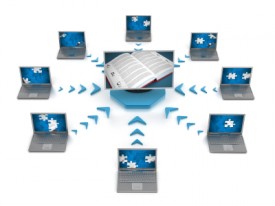
Disruptive innovation—that which "disrupts" existing markets with superior, more accessible, and ultimately less expensive offerings—has been occurring in the commercial marketplace for years. Innosight Institute executive director Michael B. Horn's recent Scientific Learning webinar, “Disrupting Class,” focuses on the ways disruptive innovation is already changing 21st century K-12 education for the better.
In the webinar, Horn identifies three prominent gains made possible by the disruptive innovation of online learning:
1) Blended Learning
Horn defines blended learningas "a formal education program in which a student learns at least in part through online delivery of instruction and content with some element of student control over time, place, path, and/or pace, AND at least in part in a supervised brick and mortar place away from home". He is careful to point out the difference between authentic blended learning, which implies a calibrated balance between the disruptive innovation of online learning and more traditional brick and mortar learning experiences, and the simple application of advanced technology in the classroom, which is not necessarily "blended learning."
2) Communication Capacity
New technologies enable educators and students to communicate, collaborate, and initiate projects with fellow educators and students, literally the world over. Communicating and collaborating worldwideis now as easy as launching your Skype application, and currently unimagined communication vehicles will have great impact on future online learning. Says Horn, "In the next ten years, I can't even imagine where this going to go!"
3) Improved Content
The actual content of online learning is much improved from the "early days" in the 90’s; current content is much more engaging. As software continues to evolve into platforms that allow the creation of user generated content, learning modules, and tools that enable the distribution of very specific content, educators will be able to find material that meets their needs at any particular time. Khan Academy is perhaps the best known example of this type of user generated content for learners, and appears to represent the emergence of a growing network of content modules that will connect to create a fuller, richer learning experience.
Click here to listento the entire Disrupting Class webinar—disruption free.
Michael B. Horn is the co-founder and executive director of the education practice of Innosight Institute, a non-profit think tank devoted to applying the theories of disruptive innovation to solve problems in the social sector. In 2008, Horn co-authored the book “Disrupting Class: How Disruptive Innovation Will Change the Way the World Learns” with Harvard Business School Professor Clayton M. Christensen, the father of disruptive innovation theory, and Curtis W. Johnson, president of the Citistates Group. BusinessWeek named the book one of the 10 Best Innovation & Design Books of 2008.
Related Reading:
Blended Learning Implementation Strategies for the K-12 Classroom
The Making of a 21st Century Educator: 5 Ways to be a Better Teacher in Today’s Classroom

